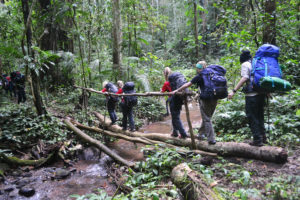Nam Ha National Protected Area (Nam Ha NPA)
Nam Ha National Protected Area (Nam Ha NPA) in the northern province of Luang Namtha covers some of the most significant and largest wilderness areas in Laos Altitudes ringing from river valleys and plans to the northern highland peaks support a broad suite of habitats with a biodiversity of national importance. This is an area of outstanding beauty, breathtaking mountain views, and cultural interest of ASEAN Heritage parks.
Most of the Nam Ha NPA is covered by mixed deciduous forest; with a range of mountains running to the border with china along the top of this are mainly dry evergreen forest and some grassland. Three large rivers, Nam Tha, Nam Fa, and Nam Long, drain southward to the Mekong fed by a dense network of tributary streams.

Nam Ha NPA is easily accessible from Luang Namtha town, Muang Sing and Vieng Phoukha. Ecotourism activities in and around the Nam Ha NPA offer visitors a unique opportunity to explore the diverse environments, stay in traditional villages and support local conservation programs.
Status:
Established by PM Decree 164, 29 October 1993.
Extensions (submission No. 1092/DoF-1999) approved by Prime Minister’s Office, 25 August 1999.
Location:
Latitude: 20° 33’-21° 15’ N
Longitude: 101° 7’-101° 37’ E
Province: Luang Namtha
Districts: Luang Namtha, Sing, Vieng Phoukha, Long and Nalae.
Boundaries:
The eastern border begins approximately 5 kilometers south of Luang Namtha and follows the Nam Tha river watershed south towards the border with Oudomxay province. Southern border lies within the Vieng Phoukha district at the upper reaches of the Nam Taleng in the southeast and the Nam Fa watershed in the southwest. The western border begins near the peak of the NBCA’s largest mountain (2,094 m) then follows the escarpment north along the headwaters of the Nam Long and Nam Ma to the headwaters of the Nam Sing near Sing district. The northern border follows the international boundary with China’s Xieng Yong Reserve.
Area:
As decreed (1993): 697 Km2
With extensions (1999): 2,224 Km2
Access:
From Luang Namtha to the southwest, there is a major road to Vieng Phoukha district and the Thailand border which passes through the corridor between Nam Ha East and West. From Luang Namtha to the north, there is a major road to Sing district which passes through the corridor between the Nam Ha West and the Nam Kong area. From Sing district to Long district there is a major new paved road which parallels the northwestern border of the NBCA to the Myanmar border. From Luang Namtha to the northeast, there is a major road to Oudomxay province and the town of Boten on the China border which parallels the NBCA boundary. From these major roads, there some small roads leading to the NBCA’s borders which are mostly accessed by tractors only. These include roads to Nam Ngen and Nam Mai villages on the east side of Nam Ha West and Suen Ya village on the east border of the Nam Kong area. The local government also has plans to make roads which would connect Nalae district with Vieng Phouka on the south border of Nam Ha East and from Vieng Phoukha to Long district on the south west border of Nam Ha West.
Principal Local Resource Uses:
An estimated 90% of the shifting cultivation activity in the NBCA is conducted by villagers living in or near the area and 10% by people from outside of the immediate area. NTFPs, primarily cardamom, rattan, bamboo, jewel orchid, eaglewood, and ginger, are harvested from the NBCA. They are used for food and sold. It is estimated that 70% of the sale of NTFPs is conducted by residents inside the NBCA and 30% by people who enter from outside of the Protected Area. Of the NTFPs harvested for food, it is estimated that 80% is used by villages in the NBCA and 20% by people from outside of the area. A wide range of wildlife is harvested for food and sale. It is estimated that 40% of the collection of wildlife for sale from the NBCA is conducted by residents and 60% by people from outside of the area. It is thought that 70% of the collection of wildlife for food is done by residents and 30% by outsiders. Some timber is harvested from the NBCA for use by people both in and outside of the area. Both local and provincial residents use lands inside the NBCA for grazing of livestock. Because livestock are free ranging, there have been cases of tiger predation of domestic buffalo.
Ethnic Composition:
The Nam Ha NBCA includes a variety of ethnic groups including Tai Lue, Tai Dam, Khmu, Akha, Lantaen, Lahu, Yao and Hmong.
Brief History of the NBCA:
- 1980: Nam Ha area identified for provincial protected area.
- 1993: Nam Ha area declared by decree 164/PM to be an NBCA.
- 1995: Nam Ha NBCA approved by local and national authorities and funding agency to launch a project for management.
- 1996: Field work implemented for socio-economic survey with cooperation between DFRC, province and WCS.
- 1997: 9 Pilot villages were selected, and the wildlife habitat inventory was conducted. Initial discussion for trekking trail in Nam Ha West done.
- 1998: First village (Nalan Village) established community-based natural resource management rules.
- 1999: Land allocation is being done and the Nam Ha Project begins.
2000-present: Land demarcation and land allocation carried out; signage installed. Community-based natural resource management rules are created by local people that live in and near the NPA’s boundaries. Most monitoring and management work in these areas is shifted to villagers, as village volunteers are identified and trained for monitoring and extension work with support from local government staff. NBCA becomes a major destination for CBE in the country. Nam Ha NBCA Entrance Permit introduced, fee is $1 per person/day.
Physical Features:
Most of the protected area is covered by mixed deciduous forest, in particular in Nam Ha East. In the Nam Ha West, a range of mountains runs from “Phou 2094” to the China/Lao border to the northeast. Along the top of this range is mainly dry evergreen forest and some grassland. Three large rivers drain southward to Mekong: the Nam Tha, Nam Fa, and Nam Long.
Elevation: 540-2094 m, most areas among 1000-1500m
Climate:
The rainy season runs from May to September. Average annual rainfall is 1,256 cm, and the maximum rainfall about 1,990. During the colder months of the dry season, from December to February, temperatures can reach as low as 5°c. In the mornings, heavy fog is common, usually clearing and becoming warm and sunny by mid-day. The average annual temperature 23.75°c.
Main Forest Types:
The majority of the NPA is covered by mixed secondary deciduous forest and includes secondary evergreen forest, particularly semi-evergreen forest and moist evergreen forest (Berkmuller, et al. 1995, Tizard et al. WCS 1997). Tizard, et. al. identified four vegetation zones in the NPA. They are the Luang Namtha plain, from 540-1000 m that includes a “mosaic of human-modified habitats” made up of bamboo, secondary evergreen forest and scrub. The Northern Highlands zone goes from 1000-2094 m with patches of primary evergreen forest mixed with secondary forest and large patches of Imperata grass. The Southern Highlands range from 1000-1572 m with both evergreen forest and scrub. The Nam Kong area along the China border ranges from 600-1556 m. It is characterized by secondary evergreen forest and scrub.
| Vertebrate class | No. of species | No. of Key species |
| Mammals | 33 | 22 |
| Birds | 288 | 18 |
| Reptiles | Not surveyed | |
| Amphibians | Not surveyed | |
| Fish | Not surveyed |
Biodiversity Values:
Tizard, et. al. (1997) identified the Southern Highlands zone, the Nam Kuaylong river valley and the spine of the Northern Highlands to contain relatively undisturbed evergreen forest and grasslands. Mammals of significance are clouded leopard, leopard, and tiger. There is a small population of gaur, Asian elephant, and a possibly unique muntjac species. The bird fauna is diverse, although contains only a few species of global significance. The area is thought to be botanically unique and diverse, although no thorough surveys have been conducted. There are a wide variety of non-timber forest products, especially Aquilaria, which can still be found in the area.
Watershed Values:
The Nam Tha watershed is the first major tributary of the Mekong River after it enters Lao PDR. It is an especially important watershed, used to support agricultural production and electricity generation along the Luang Namtha plain.
Cultural Values:
The area contains a diverse array of ethnic groups who are still highly dependent on the forest and NTFPs and living relatively traditional lifestyles.
Recreation and Tourism Values:
The area has been identified by the National Tourism Authority of Lao as having high potential for both culture and nature tourism. Boating on the Nam Ha, Nam Fa and Nam Tha rivers, as well as trekking in the NBCA is currently available. There is also an opportunity to explore caves in Vieng Phoukha and Long Districts.
Principal Threats:
Using a threat assessment methodology (Salafsky and Margolius 1999), in August 1999, the NBCA Management Unit identified and ranked the following direct threats:
- Slash and burn agriculture. 90% conducted by residents and 10% by outsiders.
- Harvest of NTFPs for sale. 70% conducted by residents and 30% by outsiders.
- Hunting of wildlife for sale. 40% conducted by residents and 60% by outsiders.
- Harvest of NTFPs for food. 80% conducted by residents and 20% by outsiders.
- Hunting of wildlife for food. 70% conducted by residents and 30% by outsiders.
- Road building which is reducing habitat and improving access for hunting and harvesting by outsiders. 100% conducted by outsiders.
- Harvest of timber resources. 50% conducted by residents and 50% by outsiders.
- Free ranging domestic animals, which disturb wildlife populations, compete for habitat, spread diseases, and increase probabilities of depredation of livestock by wildlife. 40% conducted by insiders and 60% by outsiders.
Reasons for proposed Extension or Excisions
Two extension zones were added in 1999, Nam Ha West and Nam Kong. Nam Ha West was seen as containing important evergreen forest and a mosaic of grasslands. Wildlife surveys (Tizard, et. al. 1997) had shown high populations of mammals and birds in some areas. The Nam Kong area adjoins the Xieng Yong Reserve in China and contains the only remaining population of Asian elephant in the area.






Leave a Reply
Want to join the discussion?Feel free to contribute!